There’s going to come a point in time when you’re ready to start squeezing every last bit of potential out of the funnel you’ve built.
And when it comes to sales funnel optimization, increasing your conversion rates tends to be part art, part science.
There are certain things you can do that have been proven over, and over again to help you drive more subscribers and sales through your funnel.
In this guide, we’re going to break down both the art and science behind achieving that goal while breaking down exactly why each optimization strategy works the way it does.
By the time you’re done reading, you’ll have 6 key strategies you can use right now to increase conversions.
You can skip straight to the strategies but, if you’re new here, it’s worth taking a second to understand the major difference between a sales funnel and other types of funnels — so you understand exactly why you’re making each of the optimizations we recommend.
What is a Sales Funnel?
A sales funnel, if you’re unfamiliar with the term, is a tool that businesses use to help streamline their sales process and convert new leads into sales, drive increased revenue, and improve their ROI from online marketing strategies — like paid advertising campaigns.
To truly understand the concept of what a sales funnel is — and isn’t — it’s worth taking a look at an actual funnel you would use to pour liquid.

At the top, the widest point, a large amount of liquid goes in. Then, at the bottom, the liquid is funneled into a smaller container.
In terms of business, the top of the funnel (TOF) is where traffic and audiences enter a business — similar to the front door if they had a brick & mortar shop.
This is an audience’s first engagement point with a business’s sales process.
The larger opening is the first engagement point for potential customers. Then, as those potential customers work down to the smaller exit of the funnel, touchpoints are added that help increase the know, like, and trust factor.
Now, you may have heard the term “marketing funnel” before. A marketing funnel is NOT a sales funnel.
The way they engage an audience is different.
A marketing funnel is focused on generating awareness — at the top of funnel stage — by targeting a specific demographic of people who may want to engage with your company.
The sales funnel, though, takes the engagement you’ve already generated and begins moving it through the offer and consideration stages of the sales process.
The goal of a marketing funnel is to generate attention while the goal of a sales funnel is to convert that attention into, you guessed it, sales and revenue.
A sales funnel expedites how quickly you’re able to grab someone’s attention and convert them into a new customer, especially when your business has a shorter sales cycle.
That means any optimizations you’re doing should be focused on decreasing the length of time it takes to convert someone’s attention into becoming a new customer.
Each of the strategies below can help you accomplish that mission.
Strategy #1: Create Dedicated Landing Pages
One of the most common mistakes people make with their marketing and sales funnels is thinking they can just run ads and people will buy.
While that may work in some cases, there’s a much better approach you can take.
For instance, when you’re driving traffic to a landing page, getting your message custom-targeted specifically to the person you’re targeting will dramatically increase your conversion rates.
To see what we mean, think about the freelance writing market for a second.
When it comes to freelance writing, the career path can be attractive to a wide range of people.
From stay-at-home moms looking to add additional income to their families, to school teachers during the summer months, to bloggers who want to get paid for their writing, and even people who never realized freelance writing as a career is a thing.
While you could target each of these people with a funnel tailored to teaching them about freelance writing, the potential, and how to do it…
A far more effective approach would be to target it specifically to who they are.
The message that would attract a stay-at-home mom is similar to what a school teacher during the summer would respond to.
But drilling down into them and making them even more specific will increase your conversion rates from your ad to the final sale.
To give you an example, a stay-at-home mom may respond better to a message that’s tailored to “adding extra income to your family’s reserves” while a school teacher during the summer may respond better to a message that’s along the lines of “making ends meet while school is out for the summer”.
Then a freelance blogger might respond better to a message along the lines of “get paid for your blogging skills before your blog takes off” while someone who is brand new to freelance writing may respond better to a message like “did you know you could get paid for your writing skills?”.
Each of these messages, when put onto their own dedicated landing page, would make the overall sales funnel far more effective than it would be if it targeted a general audience.
Similarly, if you’re going straight for the sale, you can use dedicated landing pages with specific triggers built into them that would help entice someone on the fence to take you up on your offer.
Check out the example below to see what we mean:
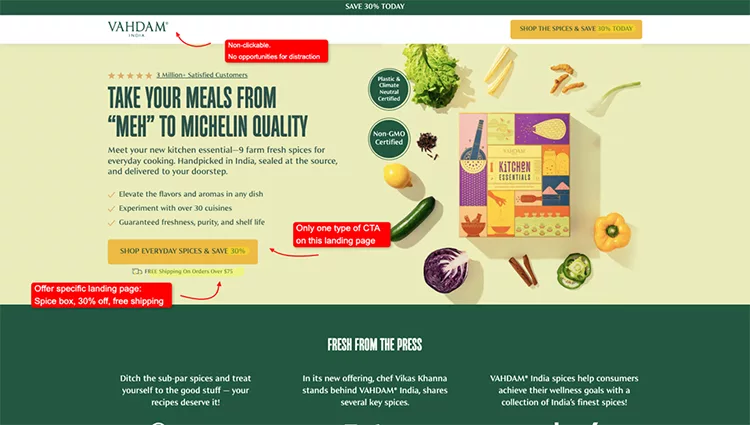
In this example, Vadham is offering a 30% discount that’s only being sent exclusively to people who opted in for one of their earlier launch offers.
By making this offer exclusive and not available to the public, while offering such a hefty discount, people who have already purchased Vadham spices are more inclined to purchase again.
And when you’re making an offer like this, it’s better to send people to a landing page with the specific offer’s details on it than it is to drive them to your full website.
Since website pages can be distracting with all the other buttons and navigation menus, it creates opportunities for people to begin wandering around instead of accepting your offer.
With a dedicated landing page, you can also effectively track the impact of the campaign you’re running.
Likewise, once the campaign has been completed, you can simply shut the landing page down without negatively impacting your website, as a whole.
You can create these landing pages inside of ClickFunnels, too, without having to rely on a tech team or web developer to help you do it.
With the built-in funnel templates, it’s easy to launch your landing pages and start driving traffic directly to them.
If you haven’t already tried it, click here to start your free 14-day ClickFunnels trial now to experience just how easy it can be.
Then, when you log into your dashboard, you’ll be able to start creating your custom landing pages.
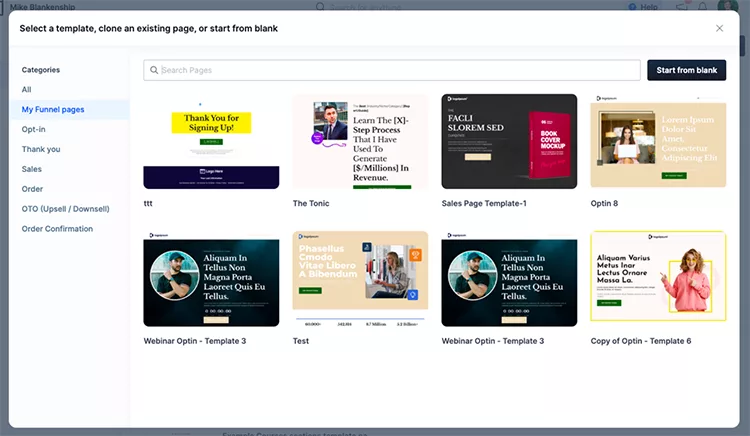
To customize them, you can begin editing anything on the template using the built-in drag-and-drop visual editor.
And if you want even deeper customizations, you can also fully edit the code underneath.
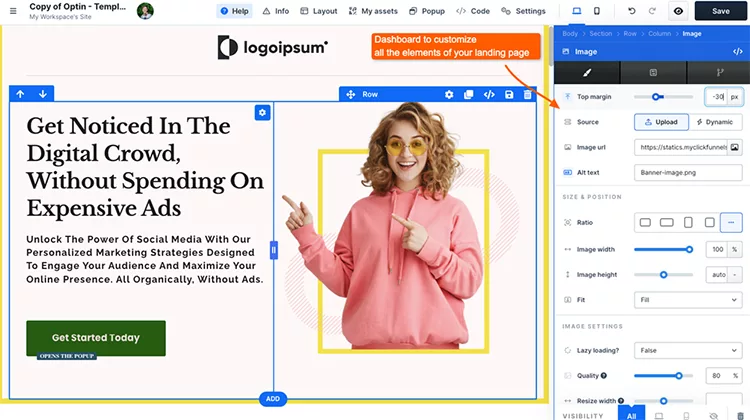
The end result is a dedicated landing page that will help increase your conversion rates and drive more revenue into your business.
Strategy #2: Create a Waitlist
Another great sales funnel optimization strategy you can use is creating a waitlist for your launches.
If you only launch a few times a year — or are planning to launch a new, fresh product — creating a landing page to collect email addresses and build an email list of people interested in your launch can be incredibly effective.
With a launch list, you can notify them when your next launch will happen or when your new product will be available for them to try.
Since people subscribing to a launch list tend to be a warmer audience and have already shown they’re interested, your conversion rate will be significantly higher than launching to a cold list.
A waitlist also creates a sense of urgency in people when they know that once the product is available it may be in limited quantity or that they may get first access to it.
This urgency can help drive quicker decision-making and purchases when you do finally launch.
Here’s an example of what this looks like in action:

With a relatively simple and straightforward approach, you can start building an email list solely with people who have already expressed their interest in your offer.
Strategy #3: Upsell & Cross-sell
When it comes to driving more sales and revenue into your business, one of the easiest sales you will make happens after someone has already purchased something.
And when you make the process of buying something else as seamless as possible, you can dramatically improve your funnel’s ROI.
By upselling and cross-selling products that are in alignment with the initial product you’ve sold, you can significantly reduce your customer acquisition cost while also boosting your average order value.
Upselling, if you’ve never heard the term before, refers to encouraging someone to purchase a higher-end comparable product.
For instance, let’s say you’re selling an eBook for $7.
Then, to make people’s lives even easier and make it more convenient for them to consume the content, you could offer them an audiobook version as an upsell for $27.
You’re selling them an additional benefit or increased value after they’ve already made the decision to purchase your initial offer.
Cross-selling, on the other hand, refers to identifying products that help satisfy complementary needs that may be left unfulfilled by the original product.
A great example of this would be someone purchasing a how-to on getting started with email marketing.
A cross-sell would be offering them a tool like ClickFunnels to help make their email marketing journey even easier.
To see what it looks like in action, check out this example:

In this example, the supplement company is using the concept of momentum of purchase to help drive more sales.
They’re making a limited-time offer to prospects in order to increase their average order value.
Chances are high that if someone purchases their supplements they’ll want to increase their supply from 1 month to 3 months.
By giving them the option to save money while increasing their supply, the customer gets what they want at a discount while the business gets what they want — in the form of a new customer and more products sold.
Implementing this strategy into your own sales funnel is a fairly easy process.
With built-in upsell funnel templates inside of ClickFunnels, you can have your upsells and cross sells ready to quickly push to your audience.

Once you’ve mapped out your funnel, you can begin using the drag-and-drop editor to make your sales pages perfectly match your brand and offers.

All of this can be created directly inside ClickFunnels without having to be a tech wizard or relying on a development team that can take forever.

You can also fully automate your email marketing in case someone doesn’t take you up on the upsell or cross-sell offer during their initial journey through your funnel.
This gives you an opportunity to keep them engaged while reminding them about the offer you made.
Like our landing page editor, you can edit your emails and sequences using the built-in drag-and-drop editor to achieve the perfect look and feel that matches your branding.

You can give these features a try for free for 14 days by clicking here now.
Strategy #4: Add Testimonials & Social Proof
One of the easiest ways to increase your conversion rate while you’re optimizing your funnel is by introducing testimonials and social proof.
When people see their thoughts and beliefs validated by someone else who has used the product you’re selling, it dramatically increases the chances they’ll want to buy it, too.
This social proof helps them see the offer as more valuable and trustworthy, helping you convert more people into new customers.
There’s different types of social proof you can use, too.
For instance, you can use the classic testimonial:

When you’re using testimonials, though, you don’t want to include anything and everything.
You want your testimonials to be focused on the thoughts and feelings new potential customers may be having toward your offer.
So if they have a common objection to purchasing it, using testimonials that specifically address how the person had the same objection and what happened after can be effective.
Likewise, if a new potential customer believes a certain thing about a feature or benefit and one of your testimonials touches on the person feeling that same thing, it’s likely the new customer will convert.
You can also use case studies as social proof:
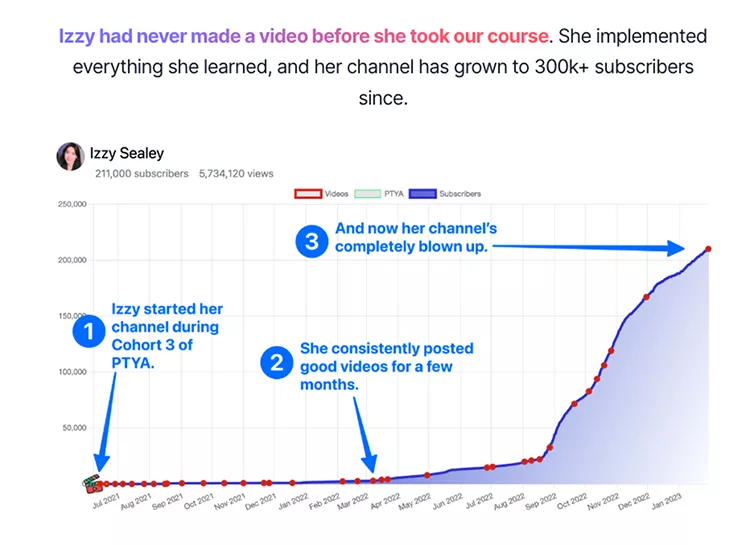
Case studies help break down the journey that the customer will go on once they buy the offer.
You can also use press mentions if you have them:

A good press mention can help build instant credibility and validation for your offer, especially if it’s from a publication that your potential customers are familiar with.
Expert endorsements can be used with great effect:

With expert endorsements, it’s not always about quantity.
Sometimes, having just a single endorsement from a well-respected expert in your field can be more powerful than dozens of testimonials from less-known users.
If you can get an expert to vouch for your product or service, it significantly boosts credibility.
Another great way to boost credibility is with user-generated content, or UGC:

When you encourage and showcase user-generated content, new potential customers can relate to the stories they’re hearing and get to see how other people are using the product and benefiting from it.
This could be anything from photos of your customers using your products to short video testimonials.
As you use this strategy, you’re getting a combination of testimonials, which are great social proof, while also getting new content that can quickly engage your users.
Another strategy is using quantitative social proof:

Social proof like testimonials tend to be more qualitative in nature.
Using numbers in your proof, though, can be a powerful persuasion tool.
For instance, if you have impressive stats, like “Helped over 10,000 businesses grow.” or “Rated 4.9 out of 5 from over 5,000 reviews.”, you’ll want to highlight that.

The key to making social proof work, though, is using the right type at the right time.
You’ll want to make sure you’re showing real faces and credentials from people who have left the testimonial.
You’ll also want to avoid using generic testimonials like “The product is great!” and, instead, showcase before-and-after stories or real-world scenarios.
If it’s a weight loss product, showcasing the transformation can be incredibly powerful.
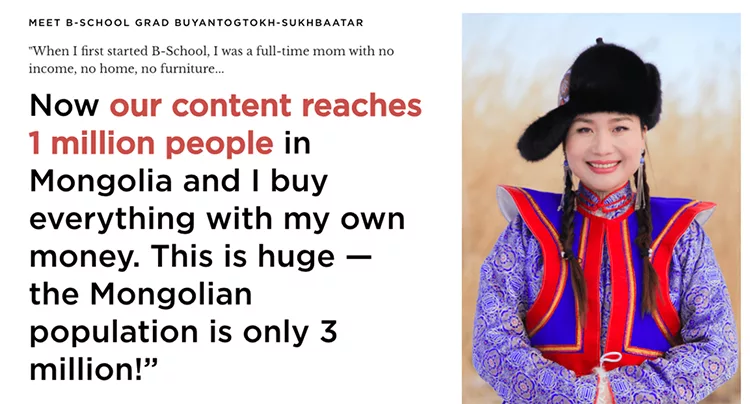
Here’s a great example of showcasing real-world stories:
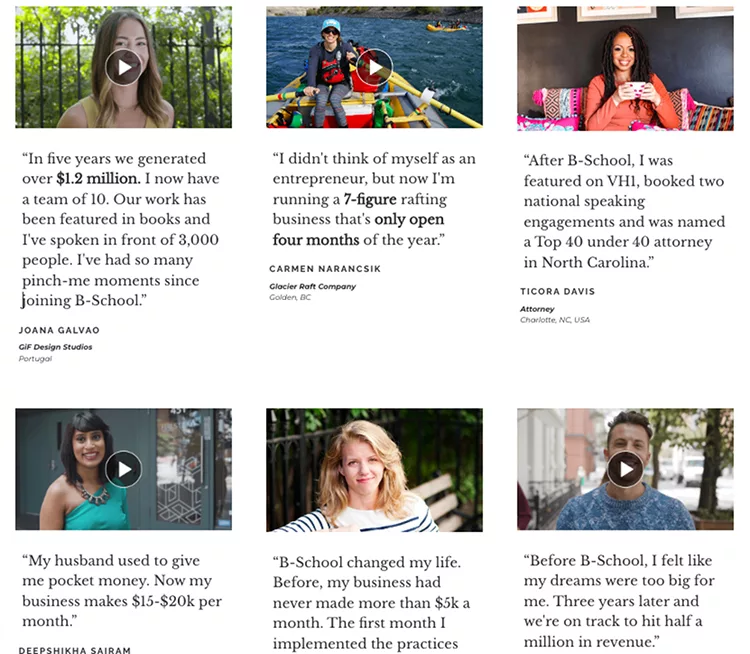
You don’t have to just create a testimonial “dump”, though, where you’re plugging all of your testimonials into the same section on your page.
You can also sprinkle them throughout the page in key areas:
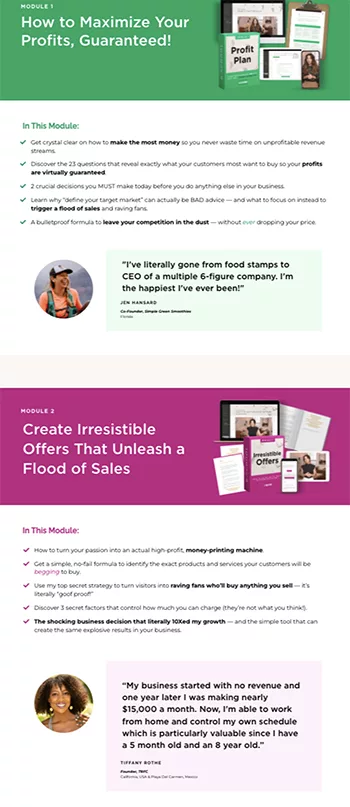
This means, if you’re selling a weight loss offer and are talking about how easy the diet is to follow, including a testimonial around how easy the diet was to follow in that specific section works great.
You can also sprinkle them into your frequently asked questions using the same approach:

When you’re using social proof and testimonials on your product and offer pages, you can dramatically increase your conversion rates.
Strategy #5: Tweak & Test Your Call to Action
The call to action (or CTA) you use on your pages can help drive more new customers to take action.
If you want to test new types of CTAs, take the traditional call to action (something along the lines of “Buy Now” or “Sign Up”) and tie it directly to a benefit.
This type of “call to value” CTA can help highlight the benefits that a user will receive when they decide to move forward.
For instance, instead of saying “Shop Now”, you can use a call-to-value like “Upgrade Your Work From Home Setup” to help make it clear what a user will receive — instead of just receiving the product.
Here’s an example that uses a call-to-value CTA:

In the example below, the soap is promising that customers will “smell like a champion”:

This company is selling spices by telling people to upgrade their spice cabinet:

You’ll want to test and tweak different benefits to see which one resonates best with your audience.
Then, you’ll want to make sure your CTAs actually stand out visually.
This doesn’t mean simply using a contrasting color and calling it a day.
You also need to position it so it’s where the viewer’s eye naturally lands as they’re consuming the copy in your message.
Then, you can add supporting statements to make your CTA even more effective:
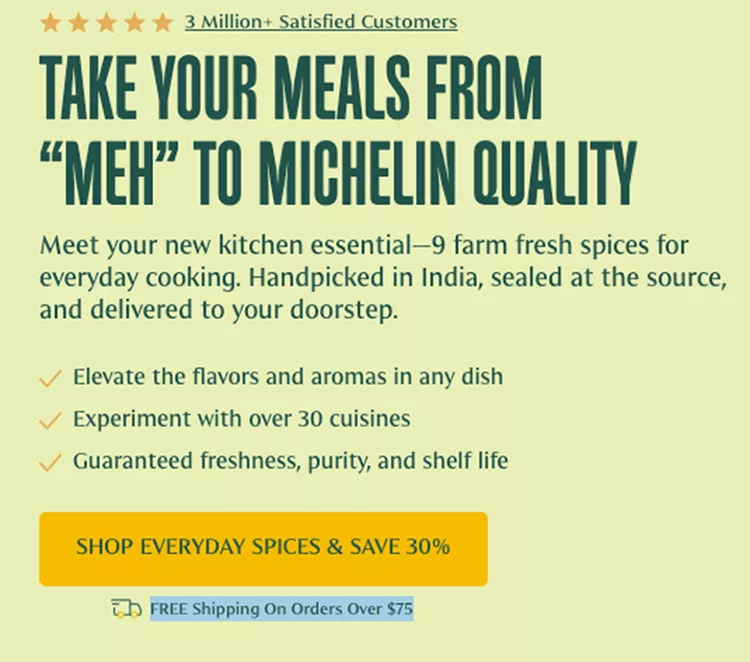
These supporting statements can help address potential objections and provide extra assurance.
For example, with a “Shop Now” CTA, you can accompany the CTA with a supporting statement like “Free Shipping” or a guarantee.
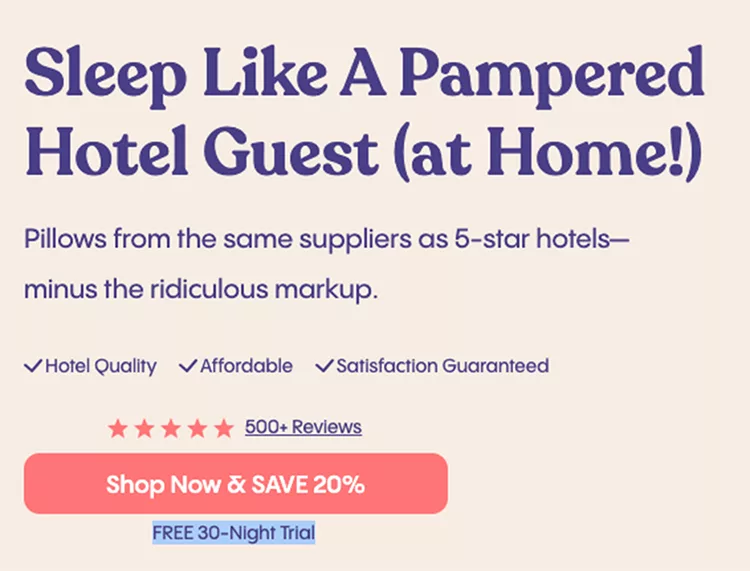
When you combine these strategies together, the social proof you include on your pages can help drive even more new customers to your business.
Strategy #6: A/B Testing
Finally, as you’re implementing each of these strategies, you’ll want to start A/B split testing.
A/B/ split testing, if you’re unfamiliar, means making a change on your funnel and then driving traffic to it while comparing results to the original version of the funnel.

To run a successful split test, you’ll want to start with a hypothesis.
This is the idea that if you change one element on the page that it will generate a positive outcome because of a specific reason.
For example, if you change your headline text from “Our Product Rocks” to something along the lines of “Increase Your Efficiency With Our Product”, then the clickthrough rate may increase because it more directly communicates the benefit to the user.
Or, if you changed your CTA color from gray to red, conversions might increase because the red CTA grabs more attention.
Or, if you change the layout to place your testimonials closer to the CTA then you may drive more conversions because the social proof is fresh in your visitor’s mind.
The key to making split testing work is to test the right elements.
Here’s a small list of what you can test in a funnel:
- Headlines and Subheadlines: Test the impact of direct versus indirect headlines, or how well different benefits or features resonate with your audience.
- Call-to-Action (CTA): Experiment with the wording of the CTA, its color, size, and its placement on the page. Each change could impact its visibility and effectiveness.
- Layout and Design: Test different layouts to see which ones enhance understanding and guide the visitor’s journey more effectively. Experiment with element placement, color schemes, whitespace usage, etc.
- Images: Images: Test different types of images (realistic, illustrative, professional, user-generated, etc.) to see which ones increase engagement and trust.
- Copy: Test different tones (formal, casual, humorous, etc.), lengths (long-form, bullet points, short and punchy, etc.), and types of information provided.
You can also test multiple ideas at once if you believe they’ll all add to a greater lift in conversions:

In this example, we’re testing multiple different elements — from the image used, to the color of fonts, the layout of the page, and even the CTA.
Above is the control that we tested against, and below is the variation:

In most cases, you would need a developer and designer to help you run split tests.
With ClickFunnels, though, A/B split testing is built in:

With just a few clicks, you can start dividing traffic between your control and your variation to see which tests and ideas will perform at a higher level.
You can test each of the different optimization strategies we’ve given you in this guide.
When put together, you can dramatically increase your conversion rates.
And you can do it all in ClickFunnels — without hiring a slow, expensive web development team.
To see what we mean, click here now to start your free 14-day trial.

